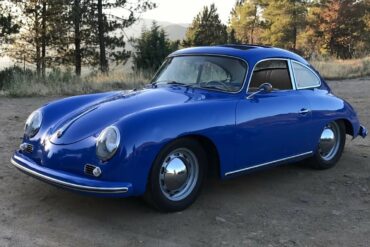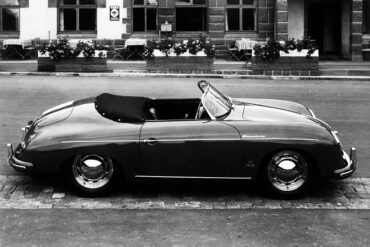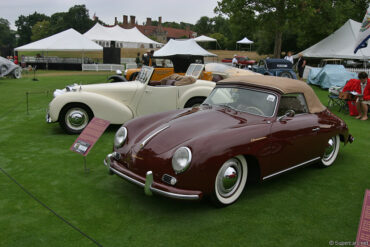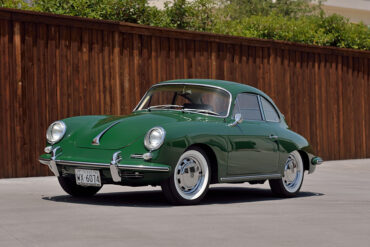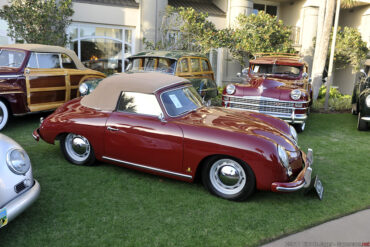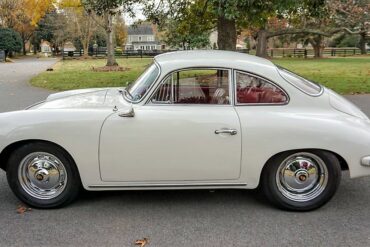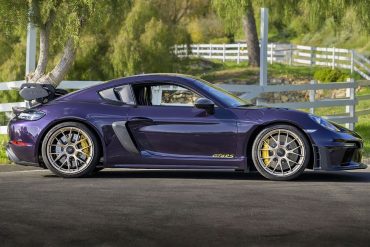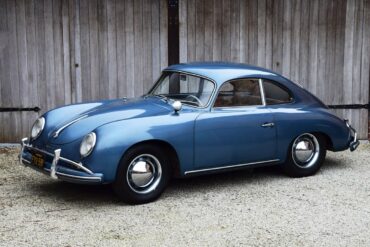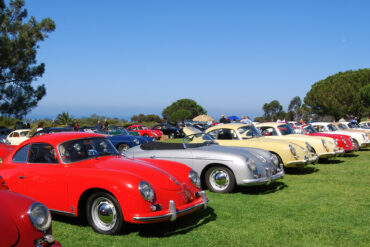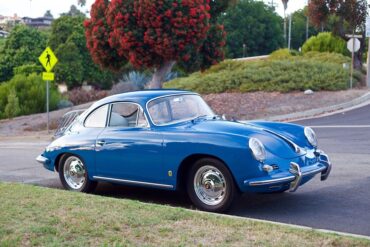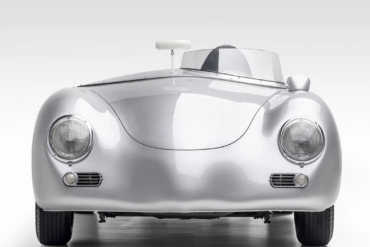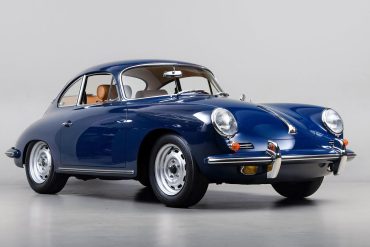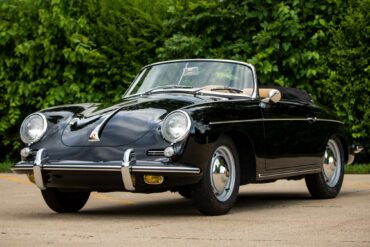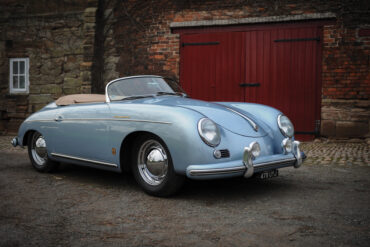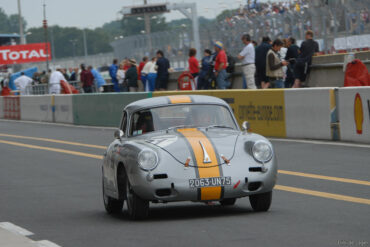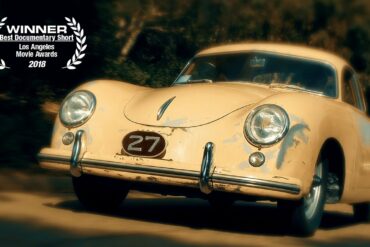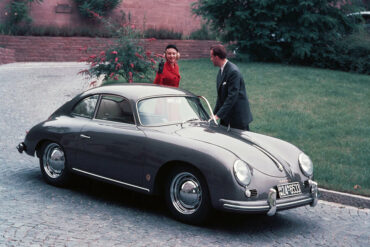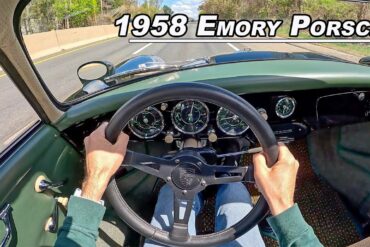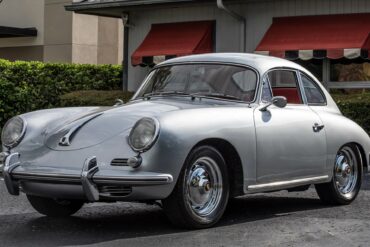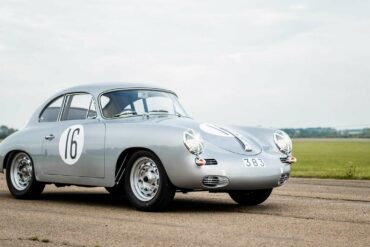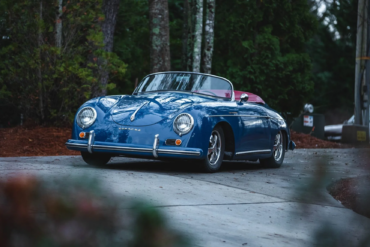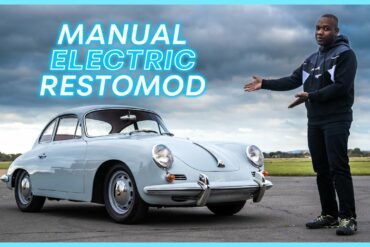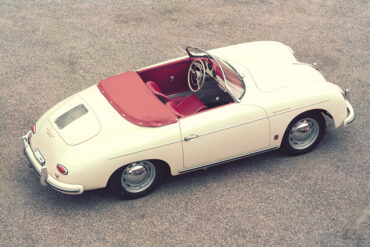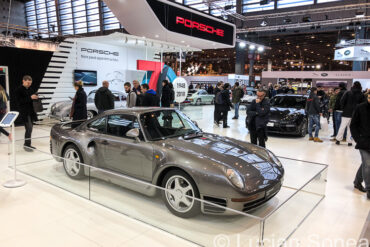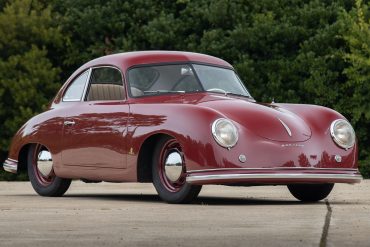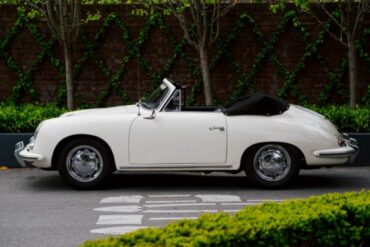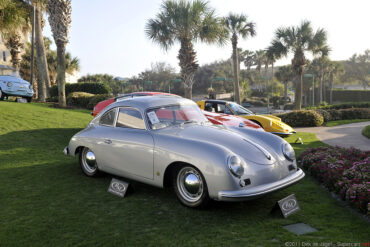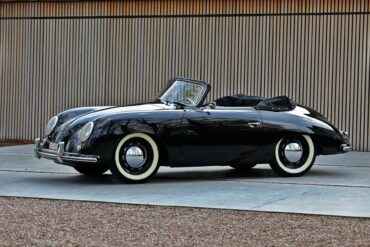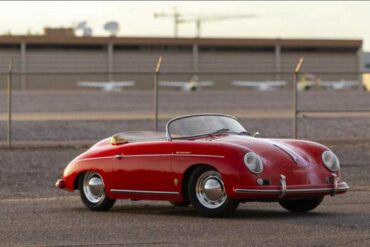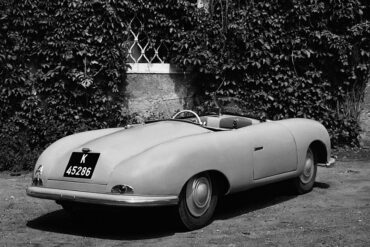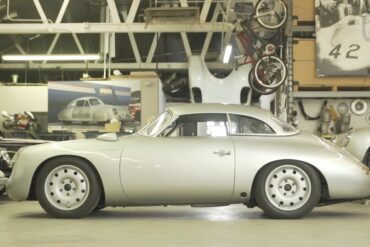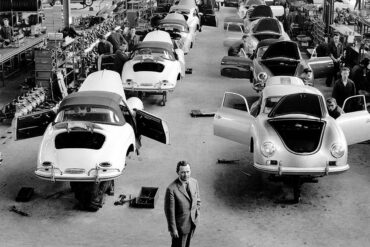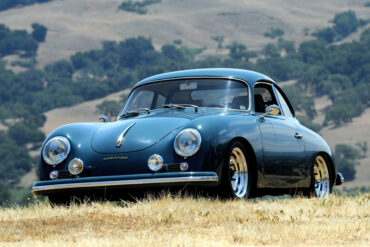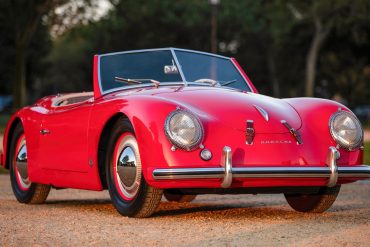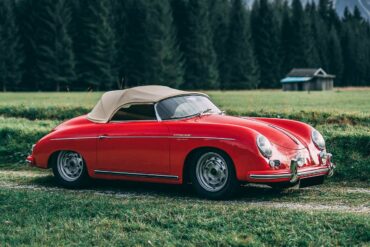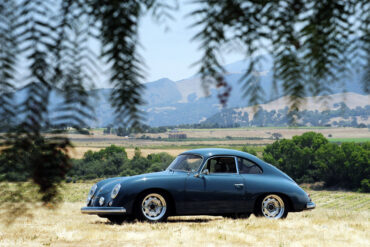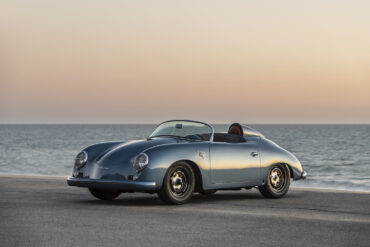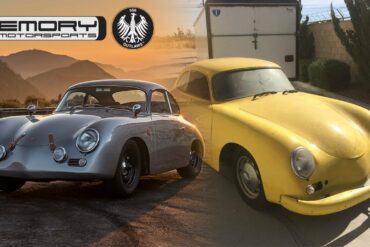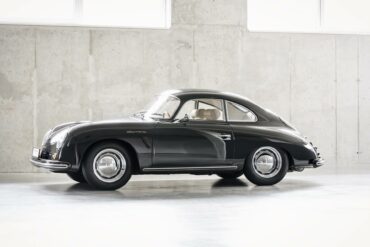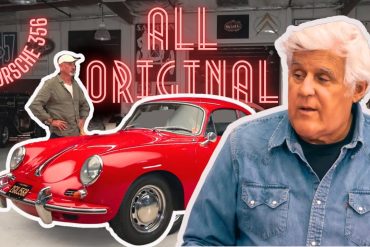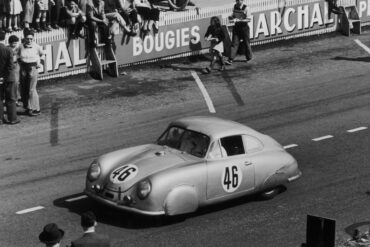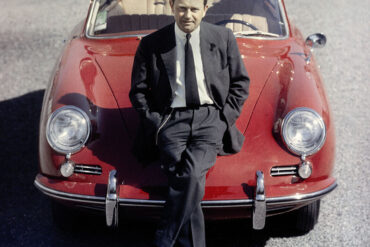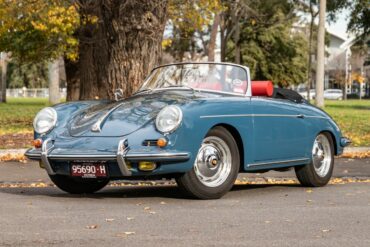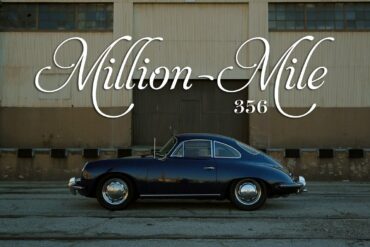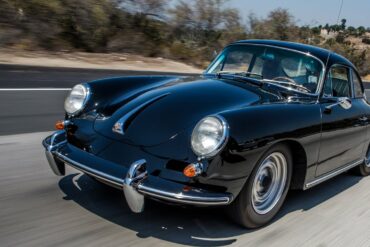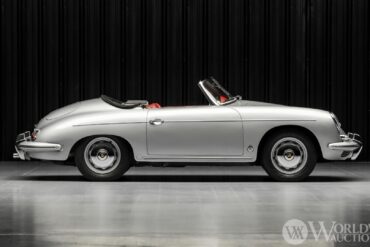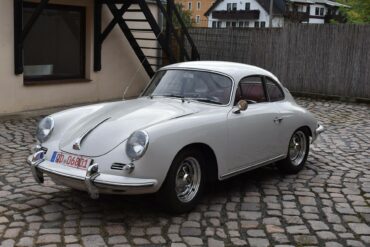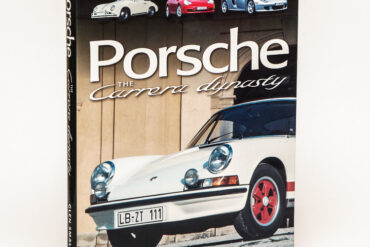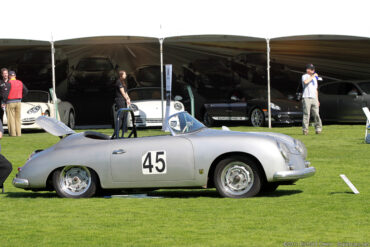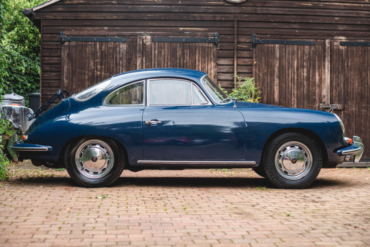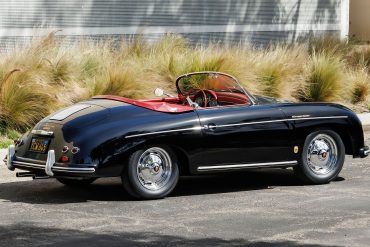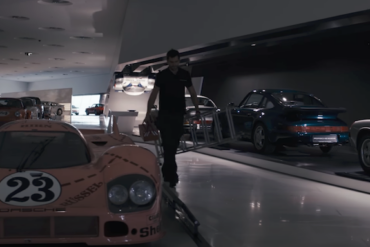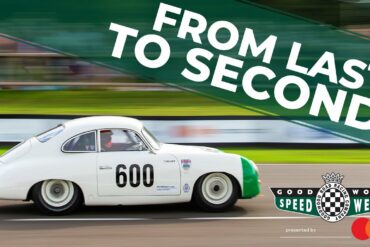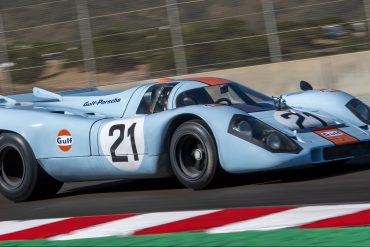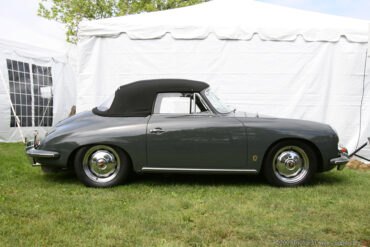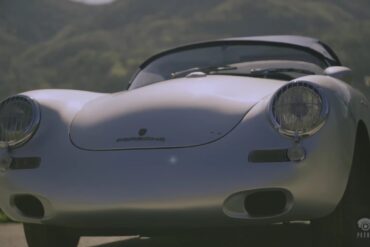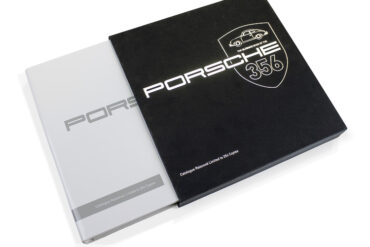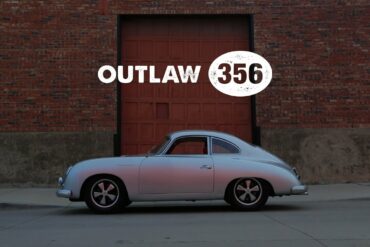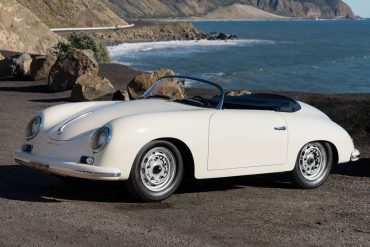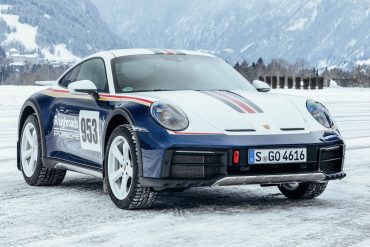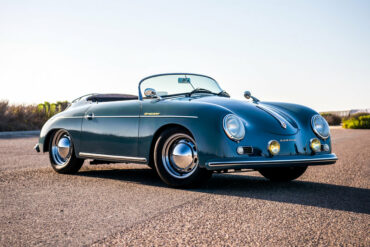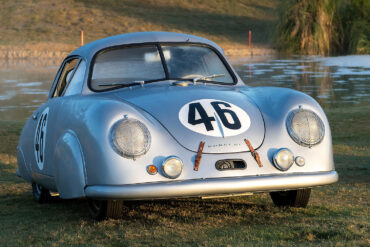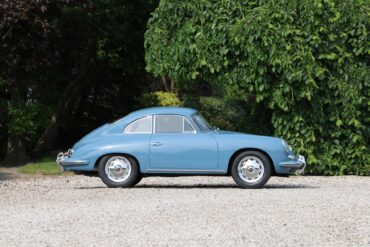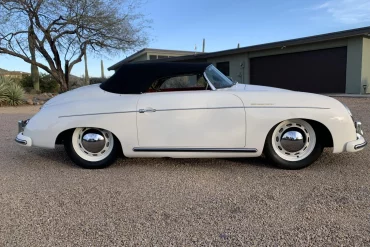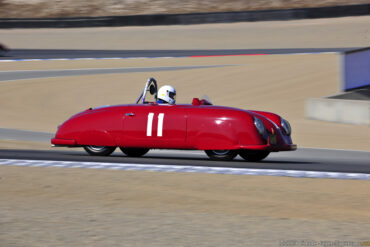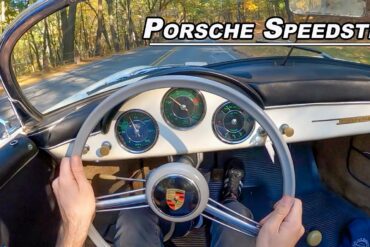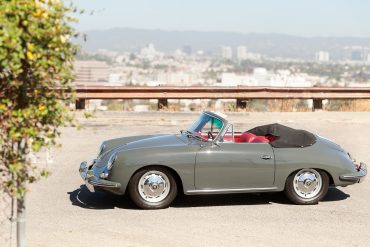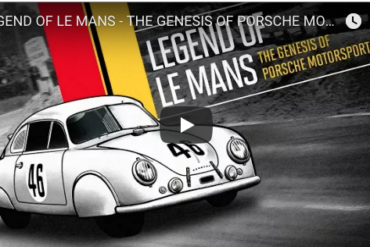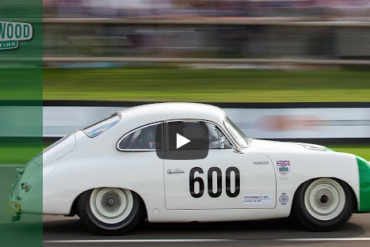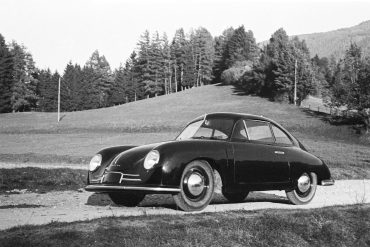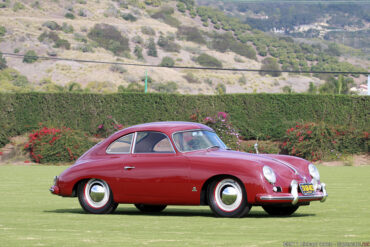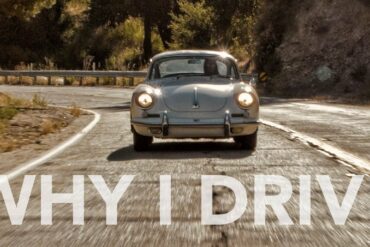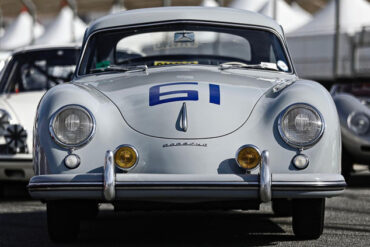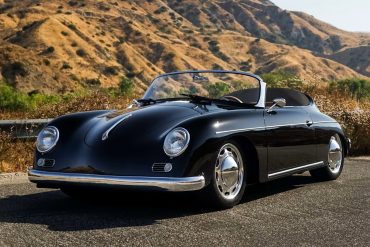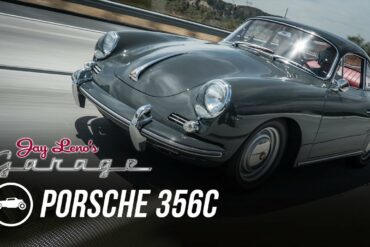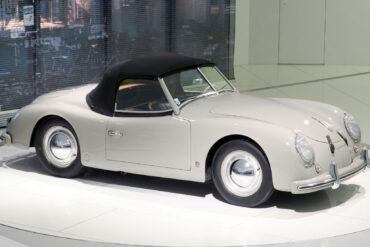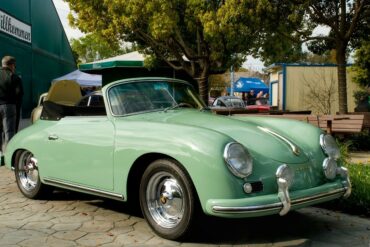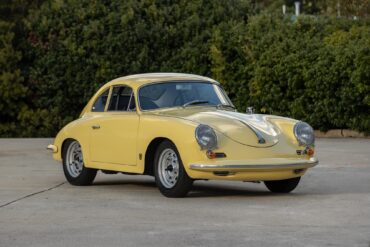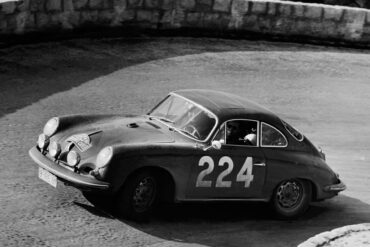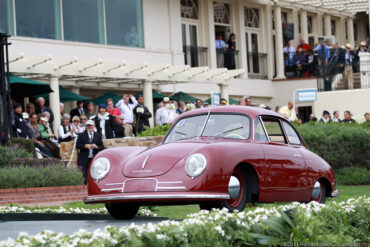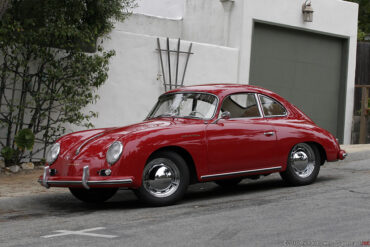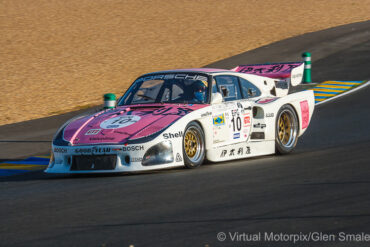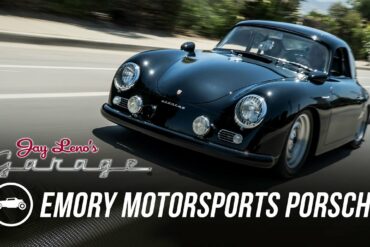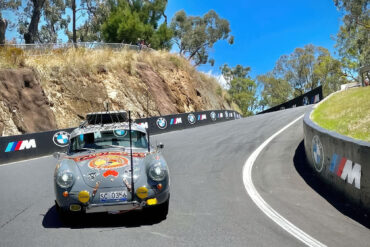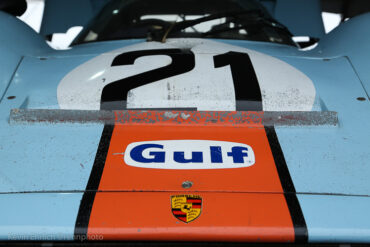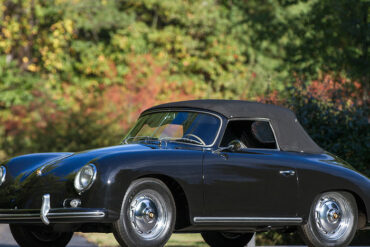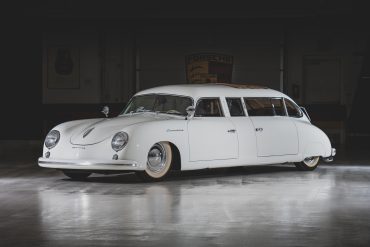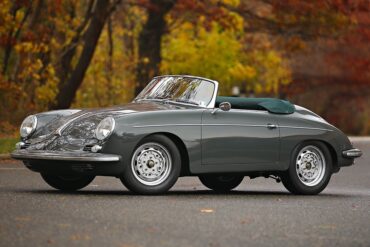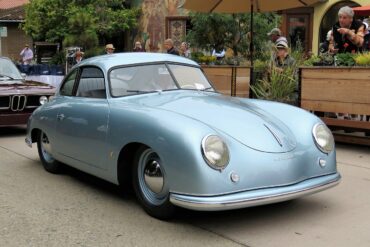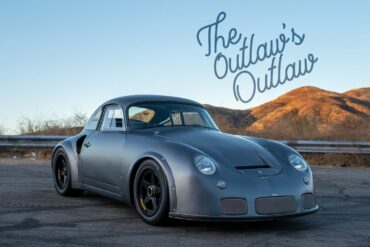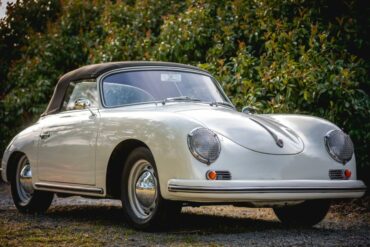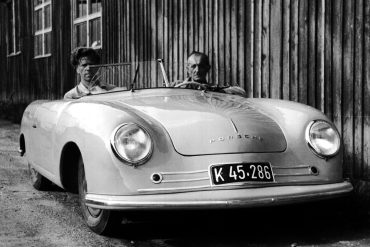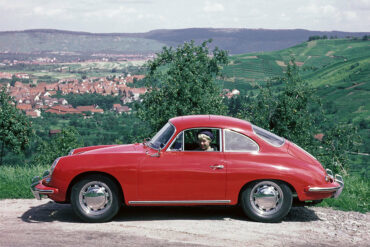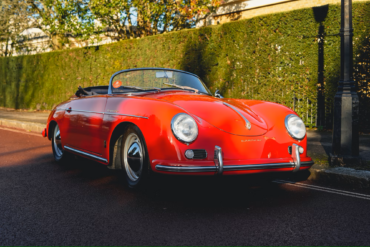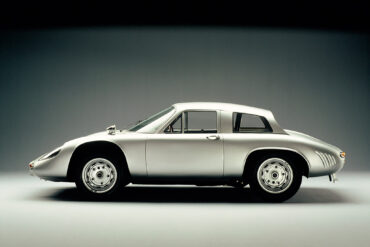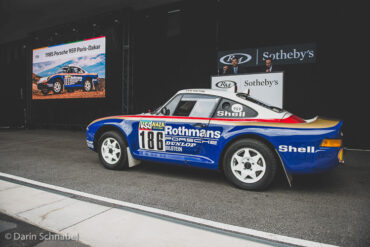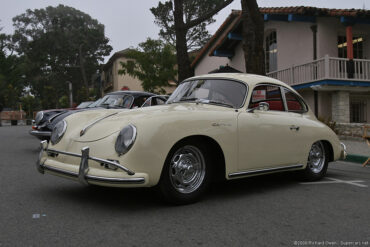1956 Porsche 356A is a “Sunroof Coupe” This 1956 Porsche 356A is a “Sunroof Coupe” that has been owned by...
Porsche 356
The Porsche 356 was the first production car from Porsche. Earlier cars designed by the company included Cisitalia Grand Prix race car, the Volkswagen Beetle, and Auto Union Grand Prix cars, but it was the 356 that changed things forever for sports car enthusiasts the world over. Ferdinand Porsche, Sr. founded the company that still bears his name, but it was his son Ferdinand, widely known as Ferry, who created the Porsche we know today. In the early years after WWII, the 356 was the car that made Porsche famous. See our Porsche 356 Research Hub
An export hit, built in response to customer demand: the American importer Max Hoffman requested a Porsche costing less than 3,000 dollars for his market. The 356 Speedster was the answer, naturally with a spartan equipment specification. But the lightweight car was a big hit in the USA. It was used mainly for motor racing and soon became a regular feature of the motor sport scene.
1955 Porsche 356/1500 Continental Cabriolet (Pre-A) Technical Specifications Type Series Production Car Built At Stuttgart, Germany Body Stylist Erwin Komenda...
Porsche 356 Paint Color Options This post outlines all the color options for the 356 over its production life. We...
1952 – 1955 Porsche 356/1500 Cabriolet (Pre-A) Technical Specifications Type Series Production Car Production Years 1952 – 1955 Built At...
Porsche 356 Spare Parts Catalogs (1960 – 1965 Model Year) Porsche 356B/356C These official Porsche PET Diagrams and codes for...
Broad Arrow Auctions, a Hagerty company, is thrilled to announce an exclusive Porsche-only auction in partnership with the first-ever Air|Water...
1956 – 1957 Porsche 356A/1300 Super Coupe Technical Specifications WHAT BODY STYLE? 2 door fixed-head coupé with 2+2 seats HOW...
Germany? Austria? Japan? To understand where ground zero is for the world’s largest 356-only Concours, let’s first go back to...
1959 – 1963 Porsche 356B/1600 S Coupe Technical Specifications Type Series Production Car Production Years 1959 – 1963 Built At...
It’s really hard not to love this Porsche 356 A Carrera Speedster! Photo Credit: Ted7 (@iamted7)...
In discussions about vintage Porsches, the iconic 356 always comes to light as the cornerstone of air-cooled Porsches. Respected for...
1959 – 1963 Porsche 356B/1600 S Roadster Pictures & Gallery...
1954 – 1955 Porsche 356/1500 Speedster Pictures & Gallery...
1959 – 1963 Porsche 356B/1600 Coupe Pictures & Gallery...
1953 Porsche 356 America After decades collecting dust in a storage building in the California desert, a 1953 Porsche 356...
Porsche 356 Spare Parts Catalogs (1950 – 1959 Model Year) Porsche 356/356A Parts These official Porsche PET Diagrams and codes for...
Rod Emory and his team at Emory Motorsports are experts in restoring and customizing Porsche 356 coupes and convertibles. Although...
PCarMarket is currently offering a 1960 Porsche 356B Sunroof Coupe that has been restored by its previous owner before it...
While all 356 Carreras are rare and desirable cars, the 1961 B Carrera GT is a very special animal indeed. Built from lightweight materials and sporting Porsche’s most powerful racing engine of the time, they were in a different league to the most highly specified road car that the Stuttgart factory then produced. Porsche produced only 49 of the 356B Carrera versions for 1960/61 and all were coupes. Many were painted Silver.
Live now on Bring A Trailer is fantastic example of a 1955 Porsche 356 Speedster finished in Oslo Blue over...
Electric Porsche 356 Review: An EV For Petrolheads! The Electrogenic 356 is no ordinary Porsche restomod. This one might look...
1956 – 1958 Porsche 356A/1600 Speedster Technical Specifications Production Years 1956 – 1958 Released At 1955 Frankfurt Motor Show Built...
Porsche 959 Coupé (only 292 models produced in 1988 in order to obtain Group B racing homologation), 6-cylinder boxer turbo,...
David vs. Goliath The story of Dr. Ferdinand Porsche is, without doubt, one of the most fascinating tales of dreams...
1964 – 1965 Porsche 356 C 1600C Cabriolet Technical Specifications Model Years 1964 – 1965 Built At Stuttgart, Germany Engine...
1952 – 1955 Porsche 356/1500 Coupe (Pre-A) Technical Specifications Type Series Production Car Production Years 1952 – 1955 Built At...
1953 – 1955 Porsche 356/1500 Super Cabriolet (Pre-A) Pictures & Gallery...
1956 – 1957 Porsche 356A/1300 Super Speedster Pictures & Gallery...
Porsche 356/1 Gmünd Coupé Specifications type Concept / Prototype Car built at Austria production 1 engine Air Cooled flat-4 displacement...
Chris Forsberg from Garage Tours goes to Los Angeles to see the stunning and impressive work that Emory Motorsports are...
1959 Porsche 356A/1600GS Carrera de Luxe Coupé Pictures & Gallery...
The world of early Porsche production This footage was taken between late 1959 and late 1961. Great view into the...
1956 – 1957 Porsche 356A/1300 Coupe Technical Specifications WHAT BODY STYLE? 2 door fixed-head coupé with 2+2 seats HOW LONG?...
It’s a rare and privileged opportunity for a vehicle to be inducted into the National Register of Historic Vehicles and...
Beginning in 1954, a new version of the Pre A 356 was introduced that is now known as the Porsche 356 Pre-A Carrera, with a powerful engine that was available in coupe, cabriolet, and Speedster variants. Highly desirable today, the Carrera name denotes the race inspired 1500 cc four cam motor that produced an astounding 110 hp. Approximately 97 of these motors were produced sometime between 1954 and early 1955. The Carrera versions would continue in the next generation 356 as the Porsche 356 A Carrera.
1954 – 1955 Porsche 356/1300 Super Coupe (Pre-A) Pictures & Gallery...
Shifting the Recipe a Bit Rod Emory of Emory Motorsports has revealed the 1959½ Speedster. It’s the latest evolution of...
How we made the 1959 Emory Outlaw RHD Coupe in GT Silver How we made the 1959 Emory Outlaw RHD...
Available in all body styles, the Porsche 356 A Carrera featured the race car-derived 1500 cc four-cam engine (type 547) developed for the Porsche 550 Spyder. Rated up to 110 hp, it was the top performance 356 A model available. Variants included the Carrera 1500GS and Carrera 1500GT, differentiated by their horsepower. In 1958, Porsche updated the Carrera engines (now type 692), increasing the displacement up to 1600 cc and output increased to 105 and 110 hp respectively. In 1959 horsepower for the GT increased again to 115.
Porsche is most renowned for the 911, but it was the 356 that first established the German brand’s reputation. In...
In 1950, eleven remaining Gmund chassis were assembled after the factory returned to Germany and converted to SL (Sport Leicht) racing specification. They received 1,086-cc engines, enlarged fuel tanks, louvered quarter-window covers, wheel spats, streamlined aluminum belly fairings, and a pedestal-mounted shifter. Three Type 356/2 cars raced at Le Mans in 1951; two crashed, but 356/2-063 performed flawlessly, winning the 1,100-cc class.
A Beautiful Piece of Porsche History The 1960 Porsche 356B Roadster is an automotive icon. The vehicle is one of...
The Porsche 356 Story Porsche engineering company had designed cars for other companies for a long time, but it was...
1959 – 1963 Porsche 356B/1600 Super 90 Roadster Pictures & Gallery...
This is what it is all about It takes a lot of driving, work, and a little bit of luck...
1963 Porsche 356 Carrera 2. When Jay was lucky enough to acquire what he calls “one of the most beautiful...
The Auburn Auction, hosted by from September 1 to 3, 2022, is just over a week away, and a lot...
1959 – 1963 Porsche 356B/1600 Super 90 Coupe Pictures & Gallery ...
Porsche: The Carrera Dynasty by Glen Smale © Glen Smale A Spanish noun, ‘carrera’ can mean road, track or race...
1958 – 1959 Porsche 356A/1600 Super GT Speedster Pictures & Gallery...
1964 – 1965 Porsche 356 SC Coupe Pictures & Gallery ...
While the staff here at Stuttcars can never get enough of Porsche’s latest GT3s and 963 prototypes, there’s true reverence...
Enjoy a close-up experience of the history of Porsche at the Porsche Museum, at night when the museum comes alive!...
8 minutes of Porsche 356 goodness British Touring Car runner-up Sam Tordoff had quite the time in the Fordwater Trophy...
Having just experienced the seventh Rennsport Reunion at Weathertech Raceway, Laguna Seca, it’s clear absolutely nothing would get in the...
1962 – 1963 Porsche 356B/2000GS Carrera 2 Cabriolet Technical Specifications Type Series Production Car Built At Germany Engine Type 548...
It’s rare for a car to be considered as a part of a family. But this Porsche 356 Speedster managed...
The Ultimate Book of the Porsche 356 by Brian Long © Veloce Publishing Limited Brian Long’s original book on the...
Featuring a curated selection of over 1,000 Porsches, Air|Water, held on April 27th, 2024, created an impressive showcase for air...
Modified his 1955 Porsche 356 Continental, Nowadays, it seems “outlaw” Porsches are everywhere and all the rage. Back in the...
Carrera Speedster In 1955, less than a year after the 356 Speedster model was introduced, Porsche built the first example...
Before we submerse ourselves in a new year of challenges and innovations, we take a look back on out top...
1956 – 1959 Porsche 356A/1600 Super Speedster Pictures & Gallery...
Proven through competition Engineering, design, innovation; while the list is long for what describes the Porsche name, it can be...
1956 – 1957 Porsche 356A/1300 Super Coupe Pictures & Gallery...
There are two interesting Porsches on offer at Bring a Trailer today: a 1955 Porsche 356 1500S Speedster coming from...
When Porsche went to Le Mans, they reverted to aluminum shells made at their first factory in Gmünd, Austria. Three of these coupes, called 356 SL, raced Le Mans. All three Le Mans cars were shipped to America by Max Hoffman and sold to Fritz Kosler, Ed Trego and John von Neumann for SCCA racing. Before the 1952 races at Torrey Pines, von Neumann had Emil Diedt remove the coupe's roof, creating in effect the first Carrera Speedster.
POV Drive In 356A Speedster This 1956 Porsche 356A Speedster is completely original and unrestored making it incredibly rare. It...
1959 – 1963 Porsche 356B/1600 S Cabriolet Technical Specifications Type Series Production Car Production Years 1959 – 1963 Built At...
THE GENESIS OF PORSCHE MOTORSPORT…watch the restoration by Rod Emory of the #46 Porsche 356 SL that won its class...
Video featuring Tordoff’s impressive run from last to 2nd in his Porsche 356 in the Fordwater Trophy at the Goodwood...
With lessons learned from 356 No. 1, Porsche developed the 356/2 as a production-ready version. The biggest concession to useability was repositioning the engine back behind the rear wheels as the original VW design. Like 356 No. 1, 356/2 was built as two-seat roadster using VW parts.
1952 – 1955 Porsche 356/1500 Coupe (Pre-A) Pictures & Gallery...
We Love This 1964 Porsche 356 Why does Catherine Sutton drive? Because looking after her car is a choice, not...
Kim Copperthite watches the Porsche 919 Hybrid Evo during its record run at the Porsche Rennsport Reunion VI, Laguna Seca,...
West Coast Customs has dramatically transformed this Porsche into a fusion of contemporary performance and the timeless body style of...
The Outlaws Third generation SoCal gearhead Rod Emory takes Jay through his 1958 Emory Special and 1959 Emory Outlaw....
Sorry, but you do not have permission to view this content....
1956 – 1959 Porsche 356A/1600 Cabriolet Pictures & Gallery...
For decades, Porsche has established itself as a renowned car manufacturer, celebrated for its adaptability and agility. It has consistently...
Amongst Porsche 356 enthusiasts, perhaps no model is more coveted than a C-Series Carrera 2. The Carrera 2 represents the culmination of Porsche’s racing technology fitted into a road car package and the ultimate performance-first sports car in the 356 model lineup. The 1,966-cubic centimeter, mechanically complex four-cam Type 587/1 engine was the most powerful unit that Porsche had ever created for a production car, developing 130 brake horsepower at 6,200 rpm.
Porsche 356/2 Gmünd Coupé Specifications type Series Production Car production years 1948 – 1951 built at Austria production 41 price...
1956 – 1959 Porsche 356A/1500GS Carrera Coupe Pictures & Gallery...
A Drive In An Emory Outlaw 356 Third generation SoCal gearhead Rod Emory takes Jay through his 1958 Emory Special...
It started with the Porsche 356 As we all know, the 356 was the first globally sold car made by...
Gulf Porsche chassis 917-016 Under the welcoming embrace of sunny California skies over wine country, the Sonoma Speed Festival established...
1956 – 1959 Porsche 356A/1600 Super Cabriolet Technical Specifications Model Year 1956 – 1959 Built At Stuttgart, Germany Body Stylist...
The man behind this 356 limousine is John Dixon who decided to create a personalized Porsche-based limousine for his daughter’s...
1959 – 1963 Porsche 356B/1600 Roadster Technical Specifications Type Series Production Car Production Years 1959 – 1963 Built At Stuttgart,...
1951 – 1953 Porsche 356/1300 Split-Window Coupe (Pre-A) Pictures & Gallery...
They call it the 356 RSR Rod Emory’s parents brought him home from the hospital in a hot-rodded short wheelbase...
1956 – 1957 Porsche 356A/1300 Super Cabriolet Technical Specifications WHAT BODY STYLE? 2 door fixed-head coupé with 2+2 seats HOW...
Sorry, but you do not have permission to view this content....
Introduced in 1963 for the 1964 model year, the base model Porsche 356 1600C Coupe was presented as the entry-level version of the last generation of the Porsche 356 Coupes. After offering standard/base model versions for the 356 A and 356 B with 60 HP engines, Porsche dropped the standard version as its base model and introduced the successor of the former mid-level 1600 Super engine variant with 75 HP, as the entry-level engine option for the 356 C generation. As with previous generations, it was also offered with the 356 C Cabriolet cars.
Collecting Cars is currently offering a 1957 Porsche 356 A Speedster that was purchased and owned for 50 years by...
1963 Porsche 356B/2000GS Carrera 2 GT Dreikantschaber Specifications type Racing Car production 2 engine Type 587, Boxer-4 fuel feed Twin...
1985 Porsche 959 Paris-Dakar – chassis #WP0ZZZ93ZFS010015 (courtesy of RM Sotheby’s) Lot #196, the 1985 Porsche 959 Paris-Dakar, outstripped its...
1959 Porsche 356A/1600GS Carrera Technical Specifications Type Series Production Car Coachbuilder Reutter Karosserie Engineers Klaus von Rücker Engine Type 692/2...


